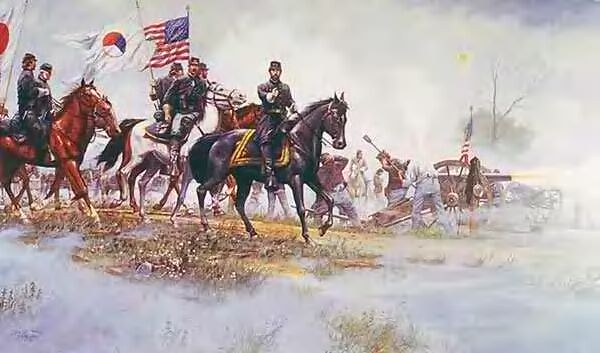<blockquote id="quote"><font size="3" face="book antiqua" id="quote">quote:<hr height="1" noshade id="quote"><i>Originally posted by Digglyda</i>
<br />As one of the voices complaining bitterly over this supposed imbalance, I feel I must add some findings/figures of my own to augment Kennons welcome research:
Using the June 30th OOB as Kennon did, I attempted to further breakdown the particulars of the Infantry on either side.
The Union AoP fields a total of 77625 men in 239 Regiments across 51 Brigades / 19 Divisions / 7 Corps. This gives a simple average Regimental strength of 325 men.
The quality of these units is divided as follows:
A & B quality Infantry: 9700 (30 Regiments across 12 Brigades)
C quality Infantry: 39450 (123 Regiments across 34 Brigades)
D quality Infantry: 27200 (82 Regiments across 21 Brigades)
E quality Infantry: 1275 (4 Regiments across 2 Brigades)
(I have omitted from my calculations the Provost guard Infantry, Corps & Divisional level Infantry detachments and those of the Artillery Reserve. This explains the discepancy between my own and Kennons figure for total strength present) This may be problematic, as these ad hoc Infantry give the Union in total an "extra" 1800 men in 15 different units present for duty. I find their inclusion in the OOB's irregular but extremely welcome from a personal gaming point of view. Their impact and influence on any game outcome is worthy of discussion?
The AoNV fields a total of 64375 Infantry in 174 regiments across 37 Brigades / 9 Divisions / 3 Corps. This gives an average regimental strength of 370 men.
The quality of these units is divided as follows:
A & B quality Infantry: 28000 (72 Regiments across 20 Brigades)
C quality Infantry: 31675 (88 Regiments across 23 Brigades)
D quality Infantry: 4700 (13 Regiments across 5 Brigades)
My contention is that the Infantry of the AoNV, being both qualitively better AND qualitively DIFFERENT (in arrangement) makes up for the fact that they are outnumbered by the AoP ...and it is this fact that I believe allows Reb players to stage in "unfair" play to their advantage. (For "unfair" read unrealistic, gamey or stylised. The Reb can commonly rout a Union line (part of at least) at first contact and maintain pressure subsequently). I fear that the large number of A & B quality Infantry make this possible.
This is a claim I have made previously about a number of scenarios on the different HPS games, but which I say is noticeably problematic on Gettysburg. Most of my games on HPS Gettysburg end in defeat or my withdrawal from the contest as a result of my rebel opponent being able to rout and disrupt my Infantry to such a degree that counters my numerical advantage. These claims are mostly based on the experience of turn based play, I find phased based play not as problematic.
I feel that the Union AoP at Gettysburg has been designed as a bludgeon, with the limitation in application of such a weapon. The only option to the Union commander is to defeat the Reb by overwhelming him through weight of force. Sensible play is rendered secondary to this fact. Positional play is largely irrelevant ...the input of the commanding officer is largely inconsequential = poor play will be punished, good play is not rewarded.
The Rebel AoNV on the other hand has been modelled as a much more lethal weapon: the larger average size of the Rebel Regiments and their higher quality allows them to employ an economy of force never achievable by the Union and most importantly to "ignore" the effects of disruption that would historically limit the offensive ability of a force from this period.
It seems that the only way to satisfy my complaint will be to play as the Reb side at Gettysburg and prove it ...one way or the other.
Taken from the Civil war battles users manual, section on morale:
"Morale refers to the mental state of the fighting units and the effect leaders have on restoring that state in the forces under their command. Units with good Morale and with inspiring leaders will fight better than units with low Morale or uninspiring leaders. Often a smaller force can overwhelm a larger one if it has superior Morale."
This in game terms is very important in understanding and agreeing on what should be possible with the forces at hand. We should be looking to see "clever" play and "daring" play being duly rewarded or punished depending on the factors involved. All too often I am seeing Reb players staging up to my prepared position in open order, extended deployments and evicting my forces from that position through frontal assault relatively easily. It is extremely difficult to equate this with what we understand from the pages of history. There is no "shock" or flanking/timing factors involved (In fairness the game engine doesn't really support the nature of factors like this anyway, even abstractly).
I would be interested to see a comprehensive list of ALL the hundreds of scenarios on the 11 game titles detailing which are actually "biased/unfair" (one way or the other) and which are truly "balanced" as gaming situations.
Brigadier-General Jim Wilkes.
2nd Brigade, Cavalry Division, XX Corps.
AoC. U.S.A.
<hr height="1" noshade id="quote"></blockquote id="quote"></font id="quote">
I agree with General Wilkes on this. Also, on a scale of 1-5. 0.5 difference is statistically very significant (in reference to Kennon's numbers). Playing either side requires vastly different playing styles. I don't think that's a bad thing but sometimes I want to be the rebel who gets to form up and charge the lines and not the Union General who has to keep reserves to plug holes and run around rallying troops all the time.
General Don Golen
I Corps /Army of the Potomac
"The Iron Corp"






